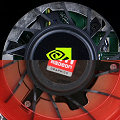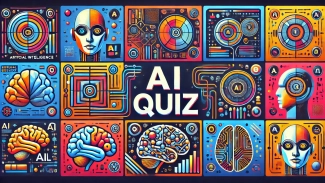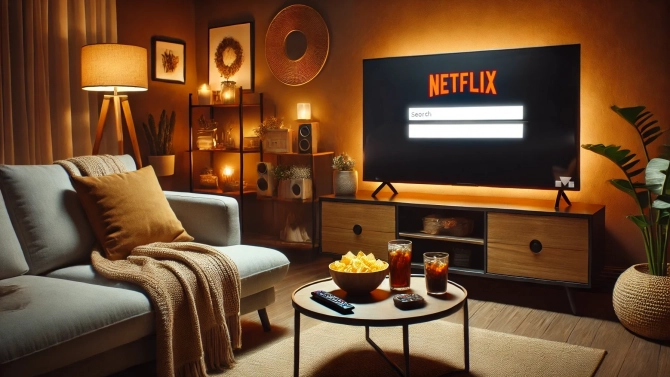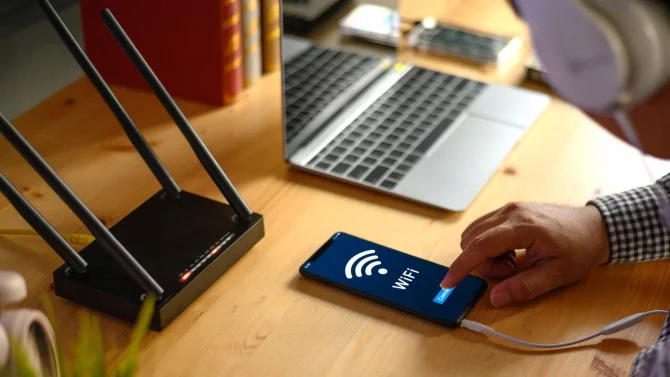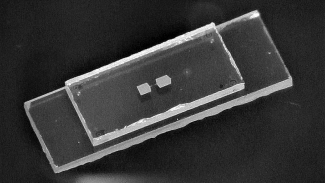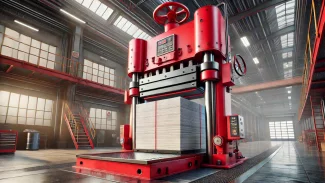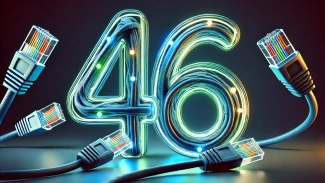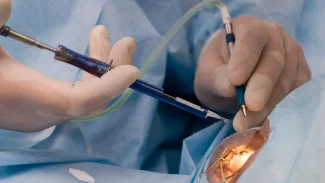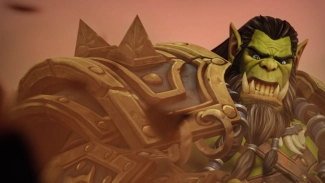Motivation of the test
On the one of my computers I got to this situation: most of used components would be for new games enough, but I knew, that with more graphically demanding games, higher resolutions (20 and 22 inch LCD panels with 1 680 × 1 050 px aren't expensive) or anti-aliasing become my old good Radeon X1950 Pro breathless. I believe that the situation: you have Athlon 64 X2 > 2 GHz or Pentium Dual-Core/Core 2 Duo > 1,8 GHz, under Windows XP still nice 2 Gigabytes of memory and this graphic cars, is not rare.
Have you already seen?
Test of Radeon HD 3850 and 3870 under Windows Vista and with Core 2 Duo E6750
CrossFire theory and test at Intel P35, Windows Vista and Core 2 Duo
In the mentioned combinations you can find such people which has two PCI Express ×16 slots for two graphic cards in CrossFire: the owners of the mainboards with chipsets like Intel 965P, P35 or ATI CrossFire Xpress 3200 (or AMD 580X). These users are maybe thinking what is better choice: buy new graphic card for 180 USD (or in particular cases more), or rather go for second Radeon X1950 Pro (CrossFire). You are able to buy this card with silent cooling for 130 USD (inc. VAT):
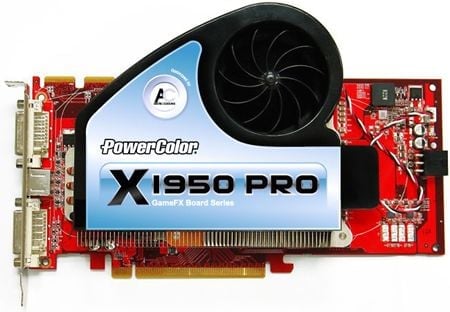
PowerColor Radeon X1950 Pro 256 MB AC2. With reasonable prace and direct with silent cooling Arctic Cooling Accelero X2. Source: www.pcmasters.de
It's not so important that the same case are cheaper Radeons X1950 GT, or if you have one X1950 Pro, you can buy X1950 GT and put it together in CrossFire (and in the ideal case overclock GT to Pro clocks). So, you can have the upgrade for 110 USD. But we are (of course) interested in the wave of new cards which are mentioned everywhere with the superlatives like incredible price/performance and performance/watt ratio. Your first idea how to upgrade Radeon X1950 Pro have to be Radeon HD 3850 256 MB. You can have this card for 180 USD:
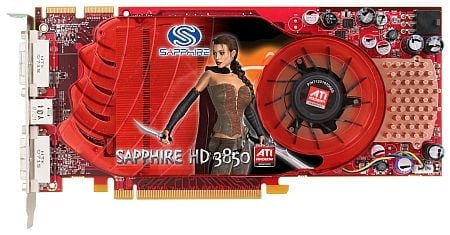
Sapphire Radeon HD 3850 256 MB was the first card we reviewed, nowadays you can obtain for similar prices for example PowerColor or Gigabyte. Source: www.sapphiretech.com
But what if the game performance depends almost only on the graphic card? In such case you could be thinking (or dreaming?) about more expensive GeForce 8800 GT 512 MB. This upgrade should be enough for longer period:

Leadtek's Extreme version has higher clocks, higher price and more shining Bioshock sticker on the cooler than common version which we tested. Source: www.octeam.fr
But now we're talking about the investment about 270 USD and therefore we have to prove if such upgrade is necessary. We focused on the resolution 1680 × 1050 px and we tested wide palette of games. We will show the impact of anti-aliaisng and anisotropic filtering and in the many games you will see the performance in 1280 × 1024 and 1920 × 1200 px too. And if you think that the fps is going up and down with some graphic cards more than with others, we also have the propriate graphs for you: we created the graphs with fps in every second for Bioshock, Call of Duty 4, Heroes of Might and Magic V and Medal of Honor: Airborne.
Tested cards and testbed
Tested Gigabyte Radeon X1950 Pro recently seemed like this:
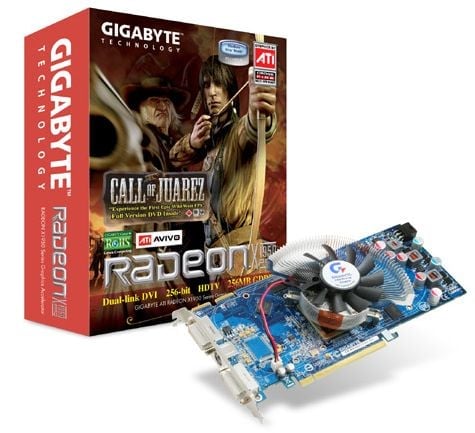
Source: www.gigabyte.co.uk
But because this model doesn't have thermal monitoring and any possibility to change or monitor rpm, you should take the noise from Zalman VF700 at 12 V. You could buy only some cheap regulator, but I changed VF700 AlCu for the more efficient VF900:

I haven't the second same X1950 Pro for CrossFire, but I did't care: the card of the same generation and same family (for example the mentioned Radeon X1950 GT) is enough and CrossFire should work without problems. So Sapphire X1950 Pro became new partner of Gigabyte's X1950 Pro. The cooler of Sapphire's card is not silent too, but you can regulate it (via ATI Tool, RivaTuner or ATi Tray Tools) and has full hardware monitoring:

ATI Radeon HD 3850 256 MB reference card from the first test of Radeons HD 3850 and 3870:
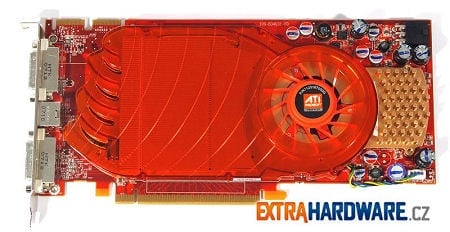
In case of GeForce 8800 GT we tested the reference sample from Nvidia too:

Putting two different Radeons X1950 Pro in CrossFire mode into service was no problem, mainboard Asus A8R32-MVP Deluxe provides enough space for dual-slot cooling and thanks to the chipset ATI CrossFire Xpress 3200 has two PCI Express graphic cards slots with full count of the PCIe lanes (16 and 16). You can compare results from this review with results from the CrossFire testing on Intel P35 chipset with PCI Express ×16 + ×4.




Testbed
| CPU | AMD Athlon 64 X2 @ 2,25 GHz (Manchester) |
| Motherboard | Asus A8R32-MVP Deluxe |
| Chipset | ATI CrossFire Xpress 3200 (RD580) + Uli M1575 |
| Sound card | Creative Labs Audigy |
| Hard drive | Western Digital Caviar SE16, 750 GB (WD7500AAKS) |
| RAM | 2× 1 GB Corsair DDR450, 2-3-2-5, 1T |
| Power supply | Corsair HX620w |
| Graphic cards | Gigabyte Radeon X1950 Pro, 256 MB GDDR3, 575/1380 MHz, 256-bit Sapphire Radeon X1950 Pro, 256 MB GDDR3, 575/1380 MHz, 256-bit ATI Radeon HD 3850, 256 MB GDDR3, 670/1660 MHz, 256-bit Nvidia GeForce 8800 GT, 512 MB GDDR3, 600/1800 MHz, 256-bit |
| Operating system | Windows XP Professional, 32-bit |
| Drivers | ATI Catalyst 7.11 WHQL Nvidia ForceWare 169.02 WHQL Nvidia ForceWare 169.09 for Crysis |
3DMark06
3DMark06
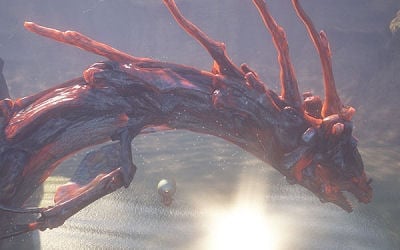

Overall score of 3DMark06 depends on CPU too, so take a look at detailed results:

Focus on almost 100 % gain with second X1950 Pro in CrossFire mode in the graphically most intensive Canyon Flight:


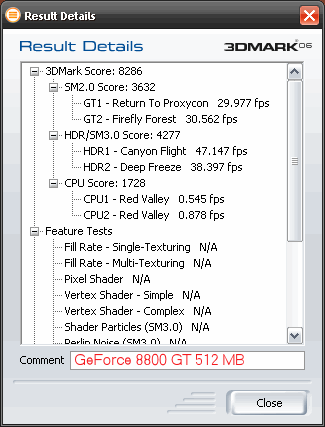
Bioshock
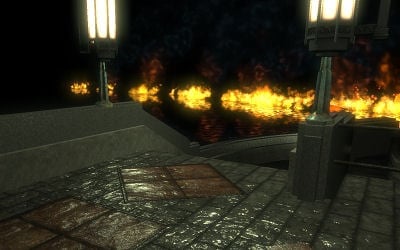
Bioshock uses Unreal 3 engine and adds some DirectX 10 surfaces. I tested with higher possible details, but I left global lighting off. The game has no built-in benchmark option and therefore I tested with the help of FRAPS. I choosed very intensive part from the start of the game (fire and lighthouse).
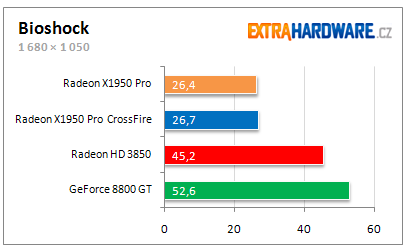

In the contrast of Windows Vista (the scaling of two Radeons HD 2900 XT was under Windows Vista in Bioshock nice) under Windows XP brings CrossFire of X1950 Pros no effect.
Call of Duty 4

Also in Call of Duty 4 I tested with FRAPS. I set all almost all details at maximum, I changed texture size to Extra and anti-aliasing and anisotropic filtering was switched on via game menu.

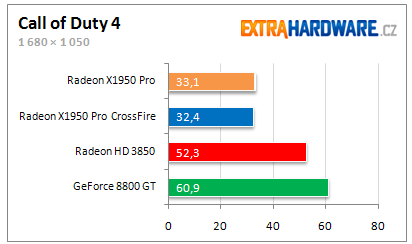


Call of Duty 4 was one of two games in which had CrossFire problems after switching anti-aliasing on. After that you could see terrible artifacts and you would be lucky if you find the menu again. So the results of CrossFire are not relevant.


Company of Heroes

I used built-in benchmark and tested version of the game is 1.71. You have to run the game with "-novsync" param to obtain right results. I set all details at maximum, instead of sound and physic. These two options were set to minimum to lower CPU impact.
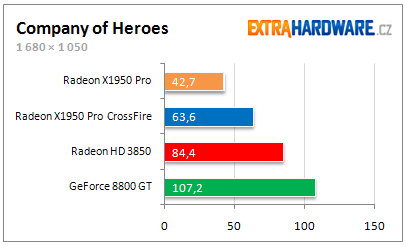
Crysis

Crysis is one of the really good reasons for buying a new graphic card. I tested with overall detail setting High, anti-aliasing and anisotropic filtering was forced via driver
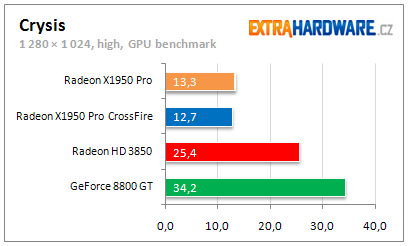
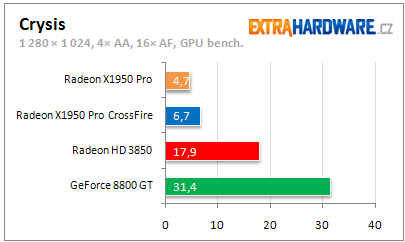
CrossFire of Radeons X1950 Pro doesn't bring any performance benefit without AA and with AA causes some artifacts (under Windows XP). Renaming of EXE file or changing Catalyst AA setting doesn't help. You will need 512MB GeForce 8800 GT or Radeon HD 3870 ror 4× MSAA in Crysis.
Enemy Territory: Quake Wars

New Enemy Territory is only one modern OpenGL game for Windows today. Quake Wars use revamped Doom 3 engine with MegaTexture technology (more in the article at Beyond3D). I tested with maximum details, only the soft articles remained off. I swiched off 30 and 60 fps limits via game console and I used own timedemo (recordtimenetdeme).
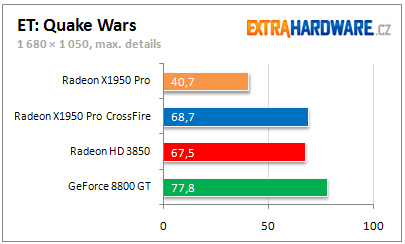
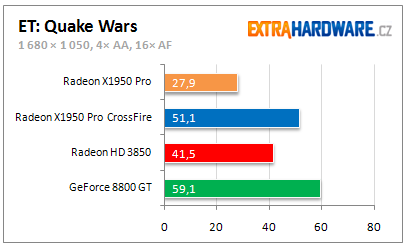
Gothic 3 a Half-Life 2: Lost Coast

Gothic 3 is good example of DirectX 9 game with HDR with only weak optimalizations. One good point is that graphic card manufacturers doesn't count with Gothic 3 among AAA game titles and they doesn't make a lot for smooth running in this game which is interesting especially for Multi-GPU.
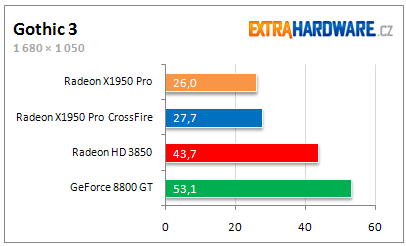
CrossFire doesn't seem to be functional again, small difference is caused by slightly different moves of main hero.
Half-Life 2: Lost Coast

Lost Coast is Source engine with the most of graphic techniques at only a small stage. I tested with maximum details (also with water reflects all), AA and AF was switched on in game menu.


Heroes of Might and Magic V

Heroes of Might and Magic V is definitely not the newest game, but with max. graphic settings is pretty demanding. Besides of that the developer is going to release datadisc Tribes of the East (january 2008), so the game will become popular once more. I tested with Hot Pursuit map and with FRAPS.

The first graph proves that GeForce 8800 GT is slightly more CPU limited than HD 3850. What is the situation with AA enabled?:


If you think that with GeForce 8800 GT wasn't anti-aliasing functional, you're wrong:



Lost Planet

Lost Planet was among the first games with DirectX 10 support. Under Windows XP I used of course DX9 version. It's important to not use game demo with obsolete code, full game patches brought many optimizations and changes. All details were set to high, Multi-GPU was set to On (only in case of two Radeons in CrossFire). I used in-game benchmark.

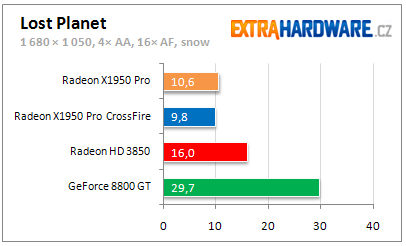
In the part of benchmark called "snow" is everything with CrossFire and MSAA right.


But in the cave section you can see strange results with AA (not functional?) and CrossFire with MSAA is slower than single card.
Medal of Honor: Airborne
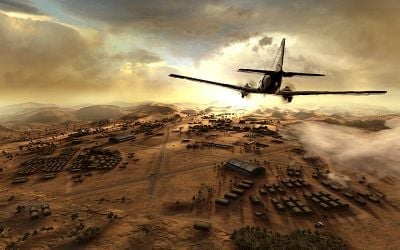
Medal of Honor: Airborne is one of new game titles built on Unreal 3 engine. The result is great: nice graphics and not so bloody hardware requirements. I tested with high details again (and second highest texture quality setting). The game hasn't built-in benchmark, so I used FRAPS.

Medal of Honor is Multi-GPU friendly, but neither two X1950 Pro are not enough to catch Radeon HD 3850. And one more thing, this CrossFire has bigger frame dropdowns:

Serious Sam 2

Older DirectX 9 game is with maximum details, HDR and higher resolutions still good graphic card benchmark. Croteam does engines well, Serious Sam 2 used many interesting technologies (for example as first ATI 3Dc compression). I used built-in benchmark option (it's possible to control it with batch script) and I measured the performance in the demo called Branchester.




Take a look at X1950 Pro with AA in 1920 × 1200 px: fps dropped incredibly down, but the speed of Radeon HD 3850 with same size of framebuffer remained good.
Splinter Cell: Chaos Theory

Splinter Cell: Chaos Theory was one of the first game with shader model 3.0 support. In the testing location (lighthouse) you can see HDR with tone mapping, parallax mapping and soft shadows.


I wasn't able to switch properly on AA with Radeon X1950 Pro and HDR on setting (there's no reason, FP16 HDR with MSAA is ok for X1000 series, so ask ATI/AMD ...) and because of that I compared only two newer cards with AA enabled:
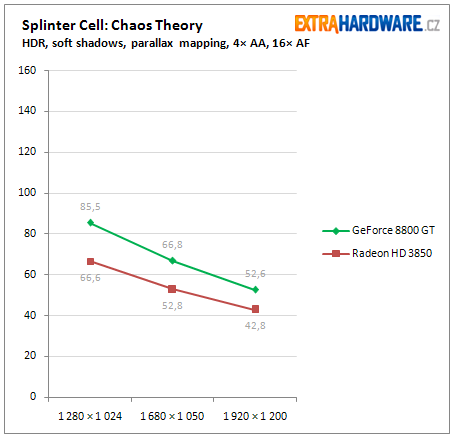
The Elder Scrolls IV: Oblivion
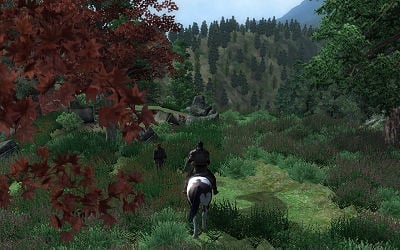
Fourth part of Elder Scrolls serie is against his age still on of the most demanding game. When you choose the locations with a lot of grass, trees and far view and you set all (self shadows, shadows from grass, HDR, ...) at maximum, you make from this game real graphic card killer.




The Witcher
If you are interested in game engine, image quality or performance optimizations in The Witcher, try to take a look at one of the most popular article at ExtraHardware.cz.
Kaer Morhen
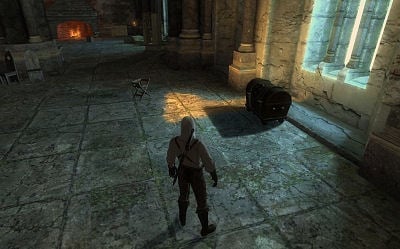
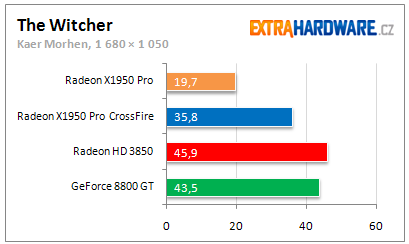


Wyzima neighbourhood
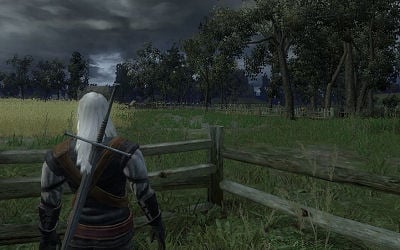
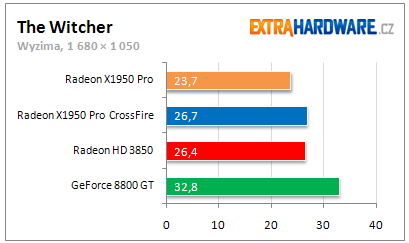

A lot of trees and other objects is causing that the cards are limited from the rest of PC:

Tomb Raider: Legend

Tomb Raider: Legend is very bad optimized game and after you switch on Next Generation Content (without that it looks like some old game) the game become tough for the most of today's PC hardware.

You have to use in-game anti-aliasing:

GeForce 8800 GT is CPU limited, CrossFire is not very effective again. Catalyst AI set to Advanced doesn't help.
Unreal Tournament 3

You have to find bSmoothFrameRate=True in UTEngine.ini file and set it to FALSE before you start benchmarking. I used UT3bench utility and ShangriLa map. I tested both modes: flyby and botmatch. I ran the botmatch bencmark three times witch each card and used the arithmetic mean to obtain relevant results.

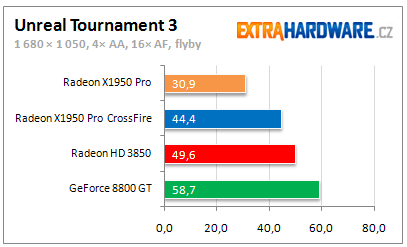


World in Conflict

World in Conflict is best looking strategy game and great CPU bencmark. I tested with customized very high detail profile (water reflects clouds on, physics low) and I used built-in bencmark.
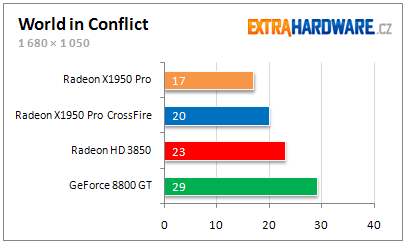

Anti-aliasing and anisotropic filtering impact, power consumption
I used reliable Serious Sam 2 engine for measuring AA/AF impact:


On of the card, GeForce 8800 GT is CPU limited, so if you are interested in deeper investigation of AA/AF impact with this card, try the article about Radeon HD 3870 and GeForce 8800 GT at ComputerBase.de. If the graph is not your cup of coffee, you can read the results from this table:
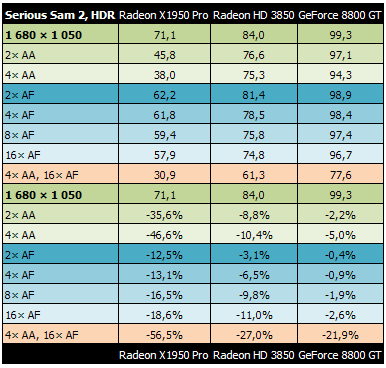
Power Consumption of whole PC

Summary, verdict
If you count all game tests in all resolutions, but without anti-aliasing and anisotropic filtering, upgrade of Radeon X1950 Pro will bring even with common CPU:
- 2× Radeon X1950 Pro CrossFire: 30,6 % performance increase
- Radeon HD 3850 256 MB: 54,5 % performance increase
- GeForce 8800 GT 512 MB: 88,9 % performance increase
Now take a look at resolution 1680 × 1050 px only (instead of Crysis where is reasonable maximum for this class of graphic cards somewhere around 1280 × 1024 px):
- 2× Radeon X1950 Pro CrossFire: 27,5 %
- Radeon HD 3850 256 MB: 55,8 %
- GeForce 8800 GT 512 MB: 92,1 %
In the last comparison without AA/AF are only the game titles which were released in 2007 (resolution 1680 × 1050 px remains):
- 2× Radeon X1950 Pro CrossFire: 27,2 %
- Radeon HD 3850 256 MB: 63,1 %
- GeForce 8800 GT 512 MB: 95,8 %
So, as you can see, CrossFire sometimes shows promising gains, but in the wide spectrum of games is average gain weak. But new cards show that the price difference is adequate, in new game titles will help even with average (or something below average) computer.
What is gain in resolution 1680 × 1050, but this time with AA (4× MSAA or in-game AA) and anisotropic filtering (16× HQAF) enabled:
- 2× Radeon X1950 Pro CrossFire: 33,8 %
- Radeon HD 3850 256 MB: 54,3 %
- GeForce 8800 GT 512 MB: 140,4 %
And now only with game titles released in 2007:
- 2× Radeon X1950 Pro CrossFire: 35,6 %
- Radeon HD 3850 256 MB: 66,6 %
- GeForce 8800 GT 512 MB: 174,3 %
I take one example (games released in 2007, 1680 × 1050 px only, noAA, noAF) for graph:

And what happens if I divide average fps and power consumption:

Despite of fact that you can upgrade to X1950 CrossFire only for 110 USD, I would't recommend it. The compatibility with many games and power consumption are strong cons. And the main argument is that Radeon HD 3850 is (on average) more powerful solution than two Radeon X1950 Pro in CrossFire, drains less power and costs acceptable 170 USD.
But if you have enough money for graphics, don't afraid to buy GeForce 8800 GT 512 MB even with dual-core CPU around 2 GHz. The price/performance and performance/watt is similar to Radeon HD 3850 and you will get the solutions for longer period.
